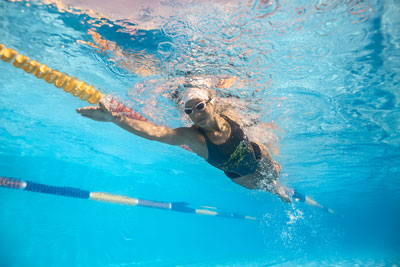Swimming: Cross Train for Athletic Success

Unless you are a competitive swimmer, you might limit your time in the water to brief dips to cool off during the summer months. Savvy athletes, however, incorporate swimming as part of their training routine for other competitive sports because they know this strategy enhances their competitive advantage. This summer consider implementing an outdoor cross-training swimming program to augment your other training efforts.
4 Benefits of a Cross-Training Swimming Program
1. Improved Fitness. Most sports involve a certain amount of cardiovascular fitness for peak performance. Swimming can greatly improve your cardiovascular strength, power, and efficiency, which will add a new dimension to your athletic performance and overall health.
2. Enhanced Recovery. Assuming that you are performing regular high intensity workouts, mixing in light workouts in the water can enhance your muscle recovery to prepare you for the next level of competition.
3. Injury Prevention. Overuse injuries are often the culprit of aerobic sports but can also affect those athletes who play their respective sport twelve months per year. Muscle imbalance, biomechanical errors, and inadequate recovery are just a few of causes of chronic or recurrent musculoskeletal injuries in sports. You can avoid over-training by substituting swimming for other sport specific workouts.
4. Rehabilitation. If you do suffer an injury, take to the lake or pool. The buoyancy of water makes it the ideal place to rehabilitate injuries because it allows you to exercise in a non-weight-bearing environment.
Interval Swimming Workout Session
Swim the freestyle stroke for 100 yards at 50% maximum effort and rest for 30 seconds. Repeat 10 times. Most novice swimmers are able to complete 100 yards in two minutes for a 4:1 ration of work to rest.
Drills for Swimming Workout Session
As you gain strength, you can add basic drills to your workouts to improve efficiency and add interest to keep from getting bored. Each drill should be performed for 25 yards with three to five repetitions.
Catch-up
Swim the freestyle stroke keeping your front arm stationary, extended forward pointing to your destination while the opposite arm performs the stroke. As the working arm “catchesup” with the stationary arm , repeat the stroke with the opposite arm.
3/4 Catch-up
The technique is the same as the Catch-up stroke, except the stationary (front) arm begins to move when the working am is about 3/4 of the way through a full stroke.
Catch-up with a Board or Noodle
In this variation of the catch-up stroke, your front hand is holding a kick board.
As the arms trade places, they hand off the board to each other.
Fist Drag
Swim the freestyle stroke with your hands closed during the entire stroke to develop power in your trunk.

